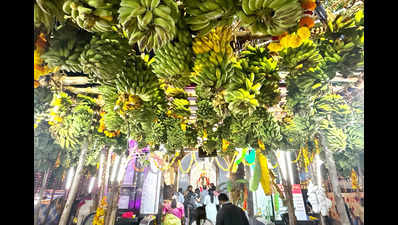
Panaji: At a church feast at Curtorim and a temple festival at Calangute, villagers continue to practice an age-old tradition of celebrating the local banana harvest.
The Kelyanchi or Ghadanchi Jatra (festival of banana rack) at Khobra Vaddo at Calangute to worship
Shree Babreshwar
, the local deity, has gained prominence over the years as devotees from across the state offer banana bunches, seeking fulfilment of a prayer or exchange for a fulfilled vow.
By the time the week-long
Kelyanchi Jatra
came to an end at the Shree Babreshwar devasthan on Sunday, the temple committee had lost count of the offerings that were made. Rough estimates suggest devotees offered over 9,000 banana racks.
“One devotee alone made an offering of 102 banana racks on the first day,” said temple committee treasurer Samir Chodankar. “He was unwell and prayed for his recovery. Here, almost every household makes an offering to Shree Babreshwar.”
Gratitude for fulfilment
The origin of the annual celebrations date back to the 16th century while the jatra has been celebrated by the temple committee here for 61 years.
Legend has it that one day the local fishermen could not catch any fish and found themselves rowing their canoes as far as the waters of Salcete taluka in South Goa. The dejected fishermen returned and made a prayer to Shree Babreshwar in desperation, seeking a good catch.
The next day, according to the legend, no sooner the fishermen set out into the waters than they found their nets full with the day’s catch.
“The catch was so abundant that they had to leave some of it and return. They came back and offered a rack of bananas to Shree Babreshwar since it was the most easily available fruit grown at home. That’s how the tradition began,” said Samir.
International draw
People, irrespective of their caste and religion, join the celebration, said temple committee president Chandrakant Chodankar. “We get a lot of curious tourists and foreigners too, all of them calling this the banana festival,” he said.
There’s a ‘banana festival’ in the south of Goa too.
In the past, people from neighbouring villages turned up at Curtorim for the feast of Our Lady of Guadalupe at the St Alex Church with bananas to sell, giving the feast the name of Kelleam Fest (banana feast).
“In the olden days, different varieties and various sizes of bananas were traded here on the feast day,” Jesuit priest Fr Apolinario Cardozo writes in ‘When Goa Celebrates’. “These came from different parts of the state, from as far as Moira in the north and from Shiroda in the south. They came by canoes since road travel was not in vogue then,” he writes. “People from Salcete would come for the feast precisely to purchase the bananas and the traders would make brisk business. They would purchase them in bulk, which later they would sell in their villages. Since the fair was laden with bananas and there was a big trade of bananas, the feast came to be called Kelleam Fest or Kelleanchem Fest, the feast of bananas.”
Kermesse upholds tradition
Now, nobody turns up with their banana produce to sell outside the church on Dec 18, the feast day, since plenty of markets have opened up, but the villagers have ensured that the tradition lives on with the Kermesse where banana bunches are auctioned.
“At the Kermesse, we have food stalls, music, entertainment, and housie but the biggest draw is always the auction (of banana bunches). We have been organising this auction for about 25 years now,” said Luis Azavedo, treasurer of Curtorim Gymkhana.
Last year, 30 banana bunches were auctioned, fetching the organisers Rs 82,000 in profit. The most expensive bunch is always the one numbered 18, the feast date, and has the best bananas.
“It was the banana trade held on the feast day that gave the name to the festival. It’s a tradition that has been kept alive for decades,” said Curtorim Gymkhana president Arnald Costa.












 English (US) ·
English (US) ·